
Government Communications Headquarters, commonly known as GCHQ, is an intelligence and security organisation responsible for providing signals intelligence (SIGINT) and information assurance to the government and armed forces of the United Kingdom. Based in "The Doughnut" in the suburbs of Cheltenham, GCHQ is the responsibility of the country's Secretary of State for Foreign and Commonwealth Affairs, but it is not a part of the Foreign Office and its Director ranks as a Permanent Secretary.

A mural is any piece of artwork painted or applied directly on a wall, ceiling or other permanent surfaces. A distinguishing characteristic of mural painting is that the architectural elements of the given space are harmoniously incorporated into the picture.
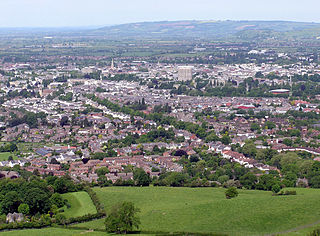
Cheltenham is a large spa town and borough on the edge of the Cotswolds in the county of Gloucestershire, England. Cheltenham became known as a health and holiday spa town resort following the discovery of mineral springs in 1716, and claims to be the most complete Regency town in Britain.

Banksy is a pseudonymous England-based street artist, political activist, and film director whose real name and identity remain unconfirmed and the subject of speculation. Active since the 1990s, his satirical street art and subversive epigrams combine dark humour with graffiti executed in a distinctive stenciling technique. His works of political and social commentary have appeared on streets, walls, and bridges throughout the world. Banksy's work grew out of the Bristol underground scene, which involved collaborations between artists and musicians. Banksy says that he was inspired by 3D, a graffiti artist and founding member of the musical group Massive Attack.

Churchdown is a village in Gloucestershire, England, situated between Gloucester and Cheltenham in the south of the Tewkesbury Borough. Churchdown is also renowned for its convenient bus routes.
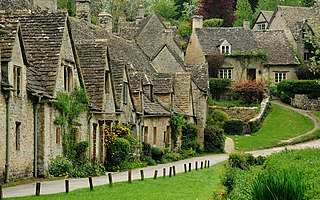
Bibury is a village and civil parish in Gloucestershire, England. It is on the River Coln, a Thames tributary that rises in the same (Cotswold) District. The village centre is 6+1⁄2 miles northeast of Cirencester. Arlington Row is a nationally notable architectural conservation area depicted on the inside cover of all British passports. It is a major destination for tourists visiting the traditional rural villages, tea houses and many historic buildings of the Cotswold District; it is one of six places in the country featured in Mini-Europe, Brussels.
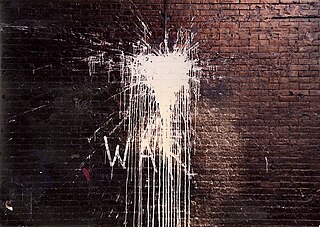
Street art is unofficial and independent visual art created in public locations for public visibility. Street art is associated with the terms "independent art", "post-graffiti", "neo-graffiti", and guerrilla art.

Leckhampton is a district in south Cheltenham, Gloucestershire, England. The area is in the civil parish of Leckhampton with Warden Hill and is part of the district of Cheltenham. The population of the civil parish taken at the 2011 census was 4,409.
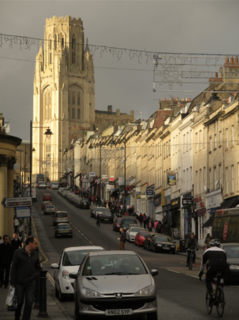
Park Street is a major shopping street in Bristol, England, linking the city centre to Clifton. It forms part of the A4018.

Since the 1980s, the area surrounding the inner-Sydney suburb of Newtown, New South Wales (NSW), Australia—including the suburbs of Newtown, Enmore, Erskineville, Camperdown and St Peters—has been known for its wide range of prominent graffiti and street art on walls. The public visual art in the Newtown area consists of a variety of styles and methods of execution, including large-scale painted murals, hand-painted political slogans, hand-painted figurative designs, spray painted semi-abstract designs "tags"), and other stylistic developments such as stencil art and street poster art, "Yarn bombing", and sculptural items cast from plaster and other materials.
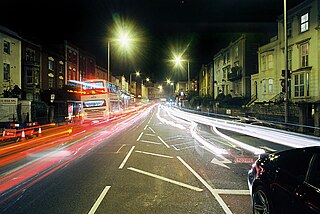
Stokes Croft is a road in Bristol, England. It is part of the A38, a main road north of the city centre. Locals refer to the area around the road by the same name.
This is a list of damaged or destroyed works of guerrilla art created by Banksy, which have been removed from their original locations or otherwise damaged or destroyed.

"The Doughnut" is the nickname given to the headquarters of the Government Communications Headquarters (GCHQ), a British cryptography and intelligence agency. It is located on a 71-hectare (176-acre) site in Benhall, in the suburbs of Cheltenham, Gloucestershire, in South West England. The Doughnut houses 5,500 employees; GCHQ is the largest single employer in Gloucestershire. Built to modernise and consolidate GCHQ's multiple buildings in Cheltenham, The Doughnut was completed in 2003, and GCHQ moved into the building in 2004. It is the largest building constructed for secret intelligence operations outside the United States. The Doughnut was too small for the number of staff at its completion, and a second building in a secret and undisclosed location in the 'Gloucestershire area' now also accommodates staff from GCHQ. The Doughnut is surrounded by car and bicycle parking in concentric rings, and is well protected by security.

Lady Bowen Hospital is a heritage-listed former maternity hospital at 497-535 Wickham Terrace, Spring Hill, City of Brisbane, Queensland, Australia. It was designed by John H. Buckeridge and built from 1889 to 1890 by John Quinn. It was also known as Brisbane Lying-In Hospital, Lady Bowen Hostel, and Anzac House & Club. It was added to the Queensland Heritage Register on 23 April 1999.
Spy Booth was an artwork by Banksy in Cheltenham, England. The piece has been seen as a critique of the global surveillance disclosures of 2013.
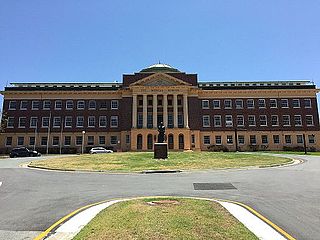
University of Queensland Mayne Medical School is a heritage-listed university building at 288 Herston Road, Herston, City of Brisbane, Queensland, Australia. It was designed by Raymond Clare Nowland and built from 1938 to 1939. It is also known as University of Queensland Medical School. It was added to the Queensland Heritage Register on 24 June 1999.

Wickham Terrace is one of the historic streets of Brisbane, Queensland, Australia. It is known as the street of private medical specialists.

The Creative Folkestone Triennial is an arts festival held every three years in Folkestone, Kent, England.
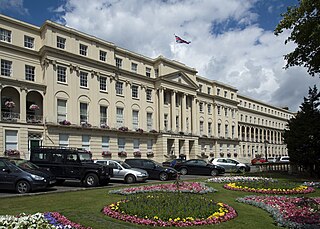
The Cheltenham Municipal Offices are a municipal facility on The Promenade, Cheltenham, England. The offices, which are the headquarters of Cheltenham Borough Council, are a Grade II* listed building.

















